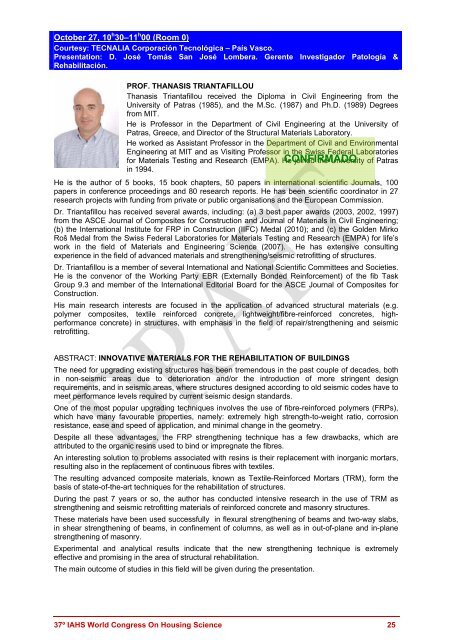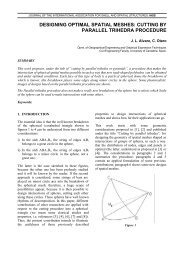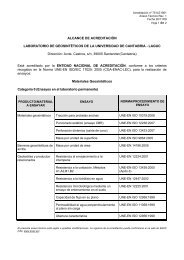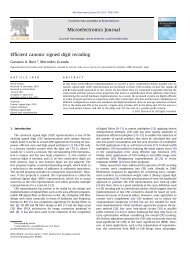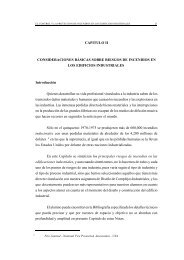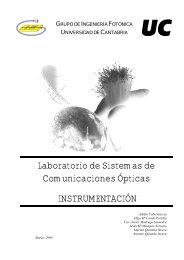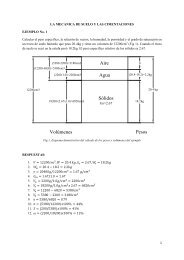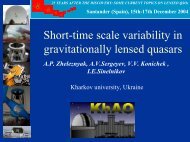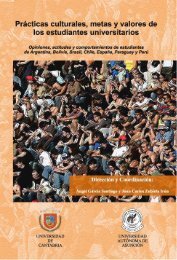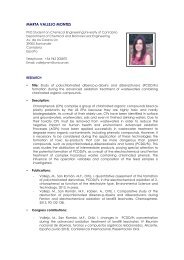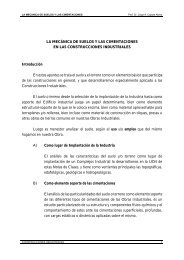37º IAHS World Congress on Housing: - Universidad de Cantabria
37º IAHS World Congress on Housing: - Universidad de Cantabria
37º IAHS World Congress on Housing: - Universidad de Cantabria
- No tags were found...
Create successful ePaper yourself
Turn your PDF publications into a flip-book with our unique Google optimized e-Paper software.
October 27, 10 h 30–11 h 00 (Room 0)Courtesy: TECNALIA Corporación Tecnológica – País Vasco.Presentati<strong>on</strong>: D. José Tomás San José Lombera. Gerente Investigador Patología &Rehabilitación.PROF. THANASIS TRIANTAFILLOUΤhanasis Triantafillou received the Diploma in Civil Engineering from theUniversity of Patras (1985), and the M.Sc. (1987) and Ph.D. (1989) Degreesfrom MIT.He is Professor in the Department of Civil Engineering at the University ofPatras, Greece, and Director of the Structural Materials Laboratory.He worked as Assistant Professor in the Department of Civil and Envir<strong>on</strong>mentalEngineering at MIT and as Visiting Professor in the Swiss Fe<strong>de</strong>ral Laboratoriesfor Materials Testing and Research (EMPA). He CONFIRMADOjoined the University of Patrasin 1994.He is the author of 5 books, 15 book chapters, 50 papers in internati<strong>on</strong>al scientific Journals, 100papers in c<strong>on</strong>ference proceedings and 80 research reports. He has been scientific coordinator in 27research projects with funding from private or public organisati<strong>on</strong>s and the European Commissi<strong>on</strong>.Dr. Triantafillou has received several awards, including: (a) 3 best paper awards (2003, 2002, 1997)from the ASCE Journal of Composites for C<strong>on</strong>structi<strong>on</strong> and Journal of Materials in Civil Engineering;(b) the Internati<strong>on</strong>al Institute for FRP in C<strong>on</strong>structi<strong>on</strong> (IIFC) Medal (2010); and (c) the Gol<strong>de</strong>n MirkoRoš Medal from the Swiss Fe<strong>de</strong>ral Laboratories for Materials Testing and Research (EMPA) for life’swork in the field of Materials and Engineering Science (2007). He has extensive c<strong>on</strong>sultingexperience in the field of advanced materials and strengthening/seismic retrofitting of structures.Dr. Triantafillou is a member of several Internati<strong>on</strong>al and Nati<strong>on</strong>al Scientific Committees and Societies.He is the c<strong>on</strong>venor of the Working Party EBR (Externally B<strong>on</strong><strong>de</strong>d Reinforcement) of the fib TaskGroup 9.3 and member of the Internati<strong>on</strong>al Editorial Board for the ASCE Journal of Composites forC<strong>on</strong>structi<strong>on</strong>.His main research interests are focused in the applicati<strong>on</strong> of advanced structural materials (e.g.polymer composites, textile reinforced c<strong>on</strong>crete, lightweight/fibre-reinforced c<strong>on</strong>cretes, highperformancec<strong>on</strong>crete) in structures, with emphasis in the field of repair/strengthening and seismicretrofitting.ABSTRACT: INNOVATIVE MATERIALS FOR THE REHABILITATION OF BUILDINGSThe need for upgrading existing structures has been tremendous in the past couple of <strong>de</strong>ca<strong>de</strong>s, bothin n<strong>on</strong>-seismic areas due to <strong>de</strong>teriorati<strong>on</strong> and/or the introducti<strong>on</strong> of more stringent <strong>de</strong>signrequirements, and in seismic areas, where structures <strong>de</strong>signed according to old seismic co<strong>de</strong>s have tomeet performance levels required by current seismic <strong>de</strong>sign standards.One of the most popular upgrading techniques involves the use of fibre-reinforced polymers (FRPs),which have many favourable properties, namely: extremely high strength-to-weight ratio, corrosi<strong>on</strong>resistance, ease and speed of applicati<strong>on</strong>, and minimal change in the geometry.Despite all these advantages, the FRP strengthening technique has a few drawbacks, which areattributed to the organic resins used to bind or impregnate the fibres.An interesting soluti<strong>on</strong> to problems associated with resins is their replacement with inorganic mortars,resulting also in the replacement of c<strong>on</strong>tinuous fibres with textiles.The resulting advanced composite materials, known as Textile-Reinforced Mortars (TRM), form thebasis of state-of-the-art techniques for the rehabilitati<strong>on</strong> of structures.During the past 7 years or so, the author has c<strong>on</strong>ducted intensive research in the use of TRM asstrengthening and seismic retrofitting materials of reinforced c<strong>on</strong>crete and mas<strong>on</strong>ry structures.These materials have been used successfully in flexural strengthening of beams and two-way slabs,in shear strengthening of beams, in c<strong>on</strong>finement of columns, as well as in out-of-plane and in-planestrengthening of mas<strong>on</strong>ry.Experimental and analytical results indicate that the new strengthening technique is extremelyeffective and promising in the area of structural rehabilitati<strong>on</strong>.The main outcome of studies in this field will be given during the presentati<strong>on</strong>.37º <str<strong>on</strong>g>IAHS</str<strong>on</strong>g> <str<strong>on</strong>g>World</str<strong>on</strong>g> <str<strong>on</strong>g>C<strong>on</strong>gress</str<strong>on</strong>g> On <strong>Housing</strong> Science 25


